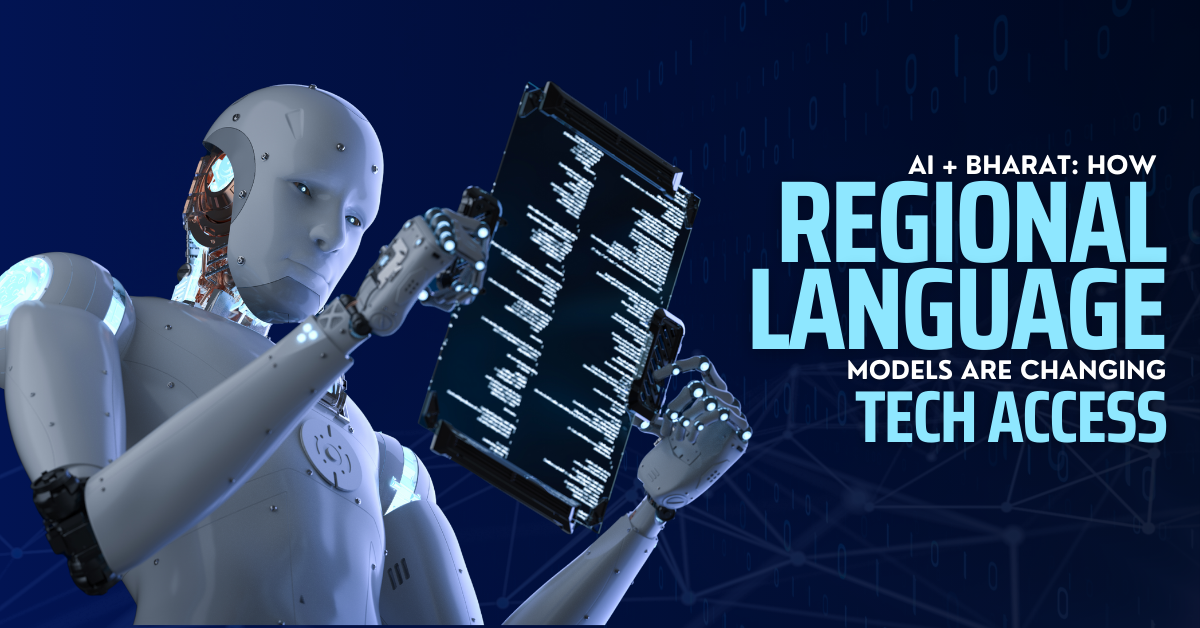In the last decade, India’s digital revolution has transformed how we connect, shop, and learn. But even as smartphone penetration increased and internet prices dropped, language remained a massive barrier. The vast majority of Indians speak and think in their regional languages, not English. Until recently, most digital tools catered to urban, English-speaking users — leaving out over 90% of India’s population.
Today, AI-powered regional language models are breaking that barrier. From voice assistants to hyperlocal content, artificial intelligence is making technology truly inclusive, accessible, and impactful for “Bharat” — the real India beyond metros.
Why India Needs AI in Regional Languages
India is home to 22 official languages and hundreds of dialects. While Hindi and English dominate national media, millions across Tamil Nadu, Odisha, Gujarat, Bengal, and the North East prefer their mother tongues.
Traditional tech tools ignored this diversity, assuming English was the default. The result? Millions were digitally excluded — unable to access healthcare info, government schemes, or even basic banking services online.
Now, with AI models trained in Indian languages, that’s changing — and fast.
The Rise of Indian Language AI Models
Several Indian and global players have invested in building language-specific AI models:
Bhashini (by Govt. of India) – A national public digital platform that supports real-time translation and speech recognition in Indian languages.
Karya & AI4Bharat (IIT Madras) – Creating large-scale open-source language datasets for low-resource Indian languages.
Samasource & EkStep – Training AI on vernacular content to enable education, health, and governance services.
These models can now understand, process, and generate natural language in Hindi, Tamil, Bengali, Marathi, Telugu, Gujarati, Kannada, and more — empowering users in their native tongues.
How Regional AI is Transforming Lives
1. Voice Assistants That Speak Local
Tools like Google Assistant and Amazon Alexa now support commands in Hindi, Tamil, and Bengali. Rural users can ask questions, play music, or set reminders in their own voice and language — no typing or English required.
“Play Hanuman Chalisa in Bhojpuri” is now just a command away.
2. Vernacular Content Creation
AI writing tools are enabling local news portals, YouTube creators, and influencers to generate scripts, subtitles, and content in multiple languages with just prompts. Platforms like ShareChat, DailyHunt, and Moj have exploded in popularity by offering regional-first content.
Creators from small towns can now speak their truth without needing to translate it.
3. Education for All, in Every Language
Startups like Doubtnut, Pratham Books, and BYJU’S use AI to deliver learning content in regional languages — from animated science lessons in Marathi to math tutorials in Assamese.
A child in Jharkhand or Kerala can now learn algebra in their mother tongue, improving retention and interest.
4. Digital Governance Made Simple
With AI-powered chatbots and IVRs, state and central governments are now offering citizen services in local languages — whether it’s applying for a ration card, knowing MGNREGA benefits, or understanding COVID guidelines.
No more struggling with English-only government portals.
5. Financial Inclusion Through Language
Banks and fintech companies like Paytm, PhonePe, and SBI YONO are integrating regional language UIs and voice commands. AI translates complex financial terms into simple, regional language explanations.
An elderly villager can now check balance, send money, or buy insurance in a language they actually understand.
Behind the Scenes: How It Works
Regional AI models rely on three pillars:
Data: Collecting huge volumes of written and spoken language from books, films, websites, and conversations.
Training: Using deep learning to train AI models to understand grammar, emotion, and context.
Tuning: Making the model culturally aware — understanding idioms, accents, and colloquialisms.
The result? Chatbots that don’t just translate, but truly understand and respond like a native speaker.
Challenges Still Ahead
Despite progress, regional language AI still faces hurdles:
Lack of clean datasets for many Indian languages
Dialects and accents vary even within states
Low awareness of available tools in rural areas
But the momentum is strong. With more funding, open-source contributions, and grassroots usage, India is on the brink of a full-scale vernacular AI revolution.
What This Means for Founders, Creators & Brands
For Founders:
The next unicorn might not be built for English speakers. Think voice-first, mobile-first, regional-first. There’s massive opportunity in education, fintech, healthcare, and agritech powered by local languages.
For Creators:
Storytellers in Bhojpuri, Marathi, and Kannada are now reaching millions. Use AI tools to subtitle, dub, or generate scripts in local languages. Speak where your audience listens.
For Brands & Marketers:
Stop chasing urban-only consumers. India’s next 500 million users want content, products, and support in their native tongue. Leverage AI to run vernacular campaigns at scale.
The Future is Multilingual — and AI is Leading It
We’re no longer talking about “digital India.” We’re entering “vernacular digital India.” An India where a farmer in Bihar can ask about crop insurance using voice. Where a mother in rural Odisha can teach her child English using an app that explains everything in Odia. Where a YouTuber in Tamil Nadu can go viral without ever typing a word in English.
This is the power of AI + Bharat. Inclusive. Empowering. Game-changing.
Read







